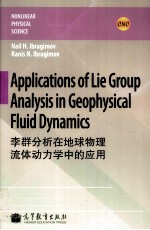图书介绍
李群分析在地球物理流体动力学中的应用 英文版pdf电子书版本下载

- RanisIbragimov,NailIbragimov著 著
- 出版社: 北京:高等教育出版社
- ISBN:9787040319545
- 出版时间:2011
- 标注页数:215页
- 文件大小:9MB
- 文件页数:225页
- 主题词:李群-应用-海洋地球物理学:流体动力学-英文
PDF下载
下载说明
李群分析在地球物理流体动力学中的应用 英文版PDF格式电子书版下载
下载的文件为RAR压缩包。需要使用解压软件进行解压得到PDF格式图书。建议使用BT下载工具Free Download Manager进行下载,简称FDM(免费,没有广告,支持多平台)。本站资源全部打包为BT种子。所以需要使用专业的BT下载软件进行下载。如 BitComet qBittorrent uTorrent等BT下载工具。迅雷目前由于本站不是热门资源。不推荐使用!后期资源热门了。安装了迅雷也可以迅雷进行下载!
(文件页数 要大于 标注页数,上中下等多册电子书除外)
注意:本站所有压缩包均有解压码: 点击下载压缩包解压工具
图书目录
PartⅠ Internal Waves in Stratified Fluid 1
1 Introduction 3
2 Governing Equations 5
2.1 Stratification 6
2.2 Linear model for small disturbances 7
2.2.1 Linearization of the boundary conditions 10
2.2.2 Linear boundary value problem 11
2.3 The Boussinesq approximation for nonlinear internal waves in continuously stratified ocean 13
2.3.1 Two-dimensional nonlinear Boussinesq equations 15
2.3.2 Dispersion relation and anisotropic property of internal waves 17
3 Two Model Examples 25
3.1 Generation of internal waves 25
3.1.1 Harmonic tidal flow over a corrugated slope 26
3.1.2 Discussion about the radiation condition 29
3.2 Reflection of internal waves from sloping topography 33
3.2.1 The problem of internal waves impinging on a sloping bottom 34
3.2.2 Direct answer to the question 36
3.2.3 Latitude anomaly as an alternative answer 39
PartⅡ Introduction to Lie Group Analysis 43
4 Calculus of Differential Algebra 47
4.1 Definitions 47
4.1.1 Main variables 47
4.1.2 Total differentiations 48
4.1.3 Differential functions 48
4.1.4 Euler-Lagrange operator 49
4.2 Properties 49
4.2.1 Divergence test 49
4.2.2 One-dimensional case 51
4.3 Exact equations 53
4.3.1 Definition 53
4.3.2 First-order equations 53
4.3.3 Second-order equations 54
4.3.4 Linear second-order equations 56
4.4 Change of variables in the space? 57
4.4.1 One independent variable 57
4.4.2 Several independent variables 59
5 Transformation Groups 61
5.1 Preliminaries 61
5.1.1 Examples from elementary mathematics 61
5.1.2 Examples from physics 64
5.1.3 Examples from fluid mechanics 66
5.2 One-parameter groups 69
5.2.1 Introduction of transformation groups 69
5.2.2 Local one-parameter groups 71
5.2.3 Local groups in canonical parameter 74
5.3 Infinitesimal description of one-parameter groups 75
5.3.1 Infinitesimal transformation 75
5.3.2 Lie equations 76
5.3.3 Exponential map 79
5.4 Invariants and invariant equations 82
5.4.1 Invariants 82
5.4.2 Invariant equations 83
5.4.3 Canonical variables 85
5.4.4 Construction of groups using canonical variables 89
5.4.5 Frequently used groups in the plane 90
6 Symmetry of Differential Equations 91
6.1 Notation 91
6.1.1 Differential equations 91
6.1.2 Transformation groups 92
6.2 Prolongation of group generators 92
6.2.1 Prolongation with one independent variable 92
6.2.2 Several independent variables 94
6.3 Definition of symmetry groups 95
6.3.1 Definition and determining equations 95
6.3.2 Construction of equations with given symmetry 96
6.3.3 Calculation of infinitesimal symmetry 98
6.4 Lie algebra 99
6.4.1 Definition of Lie algebra 99
6.4.2 Examples of Lie algebra 100
6.4.3 Invariants of multi-parameter groups 103
6.4.4 Lie algebra L2 in the plane:Canonical variables 106
6.4.5 Calculation of invariants in canonical variables 107
7 Applications of Symmetry 111
7.1 Ordinary differential equations 111
7.1.1 Integration of first-order equations 111
7.1.2 Integration of second-order equations 114
7.2 Partial differential equations 116
7.2.1 Symmetry of the Burgers equation 116
7.2.2 Invariant solutions 117
7.2.3 Group transformations of solutions 120
7.3 From symmetry to conservation laws 121
7.3.1 Introduction 121
7.3.2 Noether's theorem 123
7.3.3 Theorem of nonlocal conservation laws 125
PartⅢ Group Analysis of Internal Waves 131
8 Generalities 135
8.1 Introduction 135
8.1.1 Basic equations 135
8.1.2 Adioint system 136
8.1.3 Formal Lagrangian 136
8.2 Self-adjointness of basic equations 137
8.2.1 Adjoint system to basic equations 138
8.2.2 Self-adjointness 139
8.3 Symmetry 139
8.3.1 Obvious symmetry 139
8.3.2 General admitted Lie algebra 141
8.3.3 Admitted Lie algebra in the case f=0 142
9 Conservation Laws 143
9.1 Introduction 143
9.1.1 General discussion of conservation equations 143
9.1.2 Variational derivatives of expressions with Jacobians 145
9.1.3 Nonlocal conserved vectors 146
9.1.4 Computation of nonlocal conserved vectors 147
9.1.5 Local conserved vectors 149
9.2 Utilization of obvious symmetry 150
9.2.1 Translation ofν 150
9.2.2 Translation ofρ 151
9.2.3 Translation ofψ 151
9.2.4 Derivation of the flux of conserved vectors with known densities 152
9.2.5 Translation of x 153
9.2.6 Time translation 153
9.2.7 Conservation of energy 154
9.3 Use of semi-dilation 156
9.3.1 Computation of the conserved density 157
9.3.2 Conserved vector 158
9.4 Conservation law due to rotation 159
9.5 Summary of conservation laws 159
9.5.1 Conservation laws in integral form 160
9.5.2 Conservation laws in differential form 160
10 Group Invariant Solutions 163
10.1 Use of translations and dilation 163
10.1.1 Construction of the invariant solution 163
10.1.2 Generalized invariant solution and wave beams 166
10.1.3 Energy of the generalized invariant solution 167
10.1.4 Conserved density P of the generalized invariant solution 168
10.2 Use of rotation and dilation 172
10.2.1 The invariants 172
10.2.2 Candidates for the invariant solution 173
10.2.3 Construction of the invariant solution 174
10.2.4 Qualitative analysis of the invariant solution 175
10.2.5 Energy of the rotationally symmetric solution 176
10.2.6 Comparison with linear theory 177
10.3 Concluding remarks 180
A Resonant Triad Model 183
A.1 Weakly nonlinear model 184
A.2 Two questions 188
A.3 Solutions to the resonance conditions 189
A.4 Resonant triad model 192
A.4.1 Utilization of the GM spectrum 196
A.4.2 Model example:Energy conservation for two resonant triads 198
A.4.3 Model example:Resonant interactions between 20000 internal waves 202
A.5 Stability of the GM spectrum and open question on dissipation modelling 205
References 209
Index 213